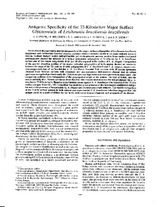Mostrar el registro sencillo del ítem
Antigenic specificity of the 72-kilodalton major surface glycoprotein of Leishmania braziliensis braziliensis
| dc.contributor.author | Kutner, S | |
| dc.contributor.author | Pellerin, P | |
| dc.contributor.author | Brenière, SF | |
| dc.contributor.author | Desjeux, P | |
| dc.contributor.author | Dedet, JP | |
| dc.date.accessioned | 2017-09-12T16:42:46Z | |
| dc.date.available | 2017-09-12T16:42:46Z | |
| dc.date.issued | 1991 | |
| dc.identifier.uri | http://repositorio.umsa.bo/xmlui/handle/123456789/12413 | |
| dc.description.abstract | We examined the expression and the antigenicity of the major surface polypeptides of Leishmania braziliensis braziliensis and Leishmania donovani chagasi, parasites which commonly coexist in the same endemic areas of Bolivia. Sodium dodecyl sulfate-polyacrylamide gel electrophoresis protein profiIes from surface-iodinated promastigotes showed the presence of a unique iodinatable polypeptide of 72 kDa on the L. b. braziliensis surface and of two major components of 65 and 50 kDa exposed at the surface of L. d. chagasi. Comparison of the peptide digestion profiles of the major iodinated polypeptides of both strains showed no similarity between the maps of the 72- and the 65-kDa polypeptides of L. b. braziliensis and L. d. chagasi, respectively. Immunoprecipitation of surface-labeled L. b. braziliensis Nonidet P-40 extracts with 35 serum specimens obtained from Bolivian patients with cutaneous and mucocutaneous leishmaniasis showed that all serum specimens recognized predominantly the 72-kDa antigen and high-molecular-mass proteins in some cases. The recognition patterns were independent of the geographical origin of the patient, the type of lesion, and the serum antibody titer. Serum specimens from children with visceral leishmaniasis did not precipitate the L. b. braziliensis 72-kDa antigen. Hamster hyperimmune serum against L. b. bmziliensis also recognized the 72-kDa surface antigen. However, this recognition was inhibited in the presence of the homologous nonlabeled antigen but not in the presence of heterologous (L. d. chagasi and Trypanosoma cruzi) antigens. The specific recognition of the 72-kDa surface antigen in both natural and experimental L. b. braziliensis infections suggests that this antigen could be a good candidate for use in the differential immunodiagnosis and prognosis of the disease. | es_ES |
| dc.language.iso | en | es_ES |
| dc.publisher | Journal of Clinical Microbiology | es_ES |
| dc.subject | GLICOPROTEÍNA DE LEISHMANIA | es_ES |
| dc.subject | LEISHMANIA BRAZILIENSIS BRAZILIENSIS | es_ES |
| dc.title | Antigenic specificity of the 72-kilodalton major surface glycoprotein of Leishmania braziliensis braziliensis | es_ES |
| dc.type | Article | es_ES |

